The El Pato Sauce copycat recipe brings the same bold flavor and heat as the classic yellow can but with fresher ingredients and cleaner taste. This homemade version blends ripe tomatoes, chilies, and spices into a smooth, rich sauce that enhances tacos, rice, and enchiladas. It delivers the authentic flavor you love while giving you control over spice, salt, and texture.
By making your own version at home, you skip preservatives and create a sauce that tastes brighter and more balanced. Whether you prefer mild or fiery, this recipe adapts easily to your taste. You’ll find full steps, ingredient swaps, and a comparison with the original sauce below.
For more Mexican-inspired recipes, visit our Mexican Recipe Hub to explore other popular sauces like Homemade Green Enchilada Sauce and Mexican Hot Sauce Recipe.
What Is El Pato Sauce and Why Make This Copycat Recipe.
El Pato Sauce is a classic Mexican-style tomato sauce with a mild to medium heat level. It blends smooth, cooked tomatoes with spices like paprika, cumin, garlic, and chili peppers to create a bright, spicy base. Its name, “El Pato,” means “the duck” in Spanish, but the sauce itself is all about tomatoes and chilies, not poultry.
The original canned version, made by Walker Foods in Los Angeles, has been a staple in American kitchens since the 1900s. It is known for its balance of tomato sweetness and chili sharpness, which pairs well with both traditional Mexican and Tex-Mex dishes. Cooks use it as a quick sauce for tacos, enchiladas, rice bowls, and even pasta.
This El Pato copycat recipe mirrors the flavor of the store-bought sauce while allowing for personal adjustments. You can use fresh or canned tomatoes, tweak the acidity, and manage the spice level to match your taste. The homemade version also avoids preservatives and gives a fresher, cleaner flavor that stands out in every dish.
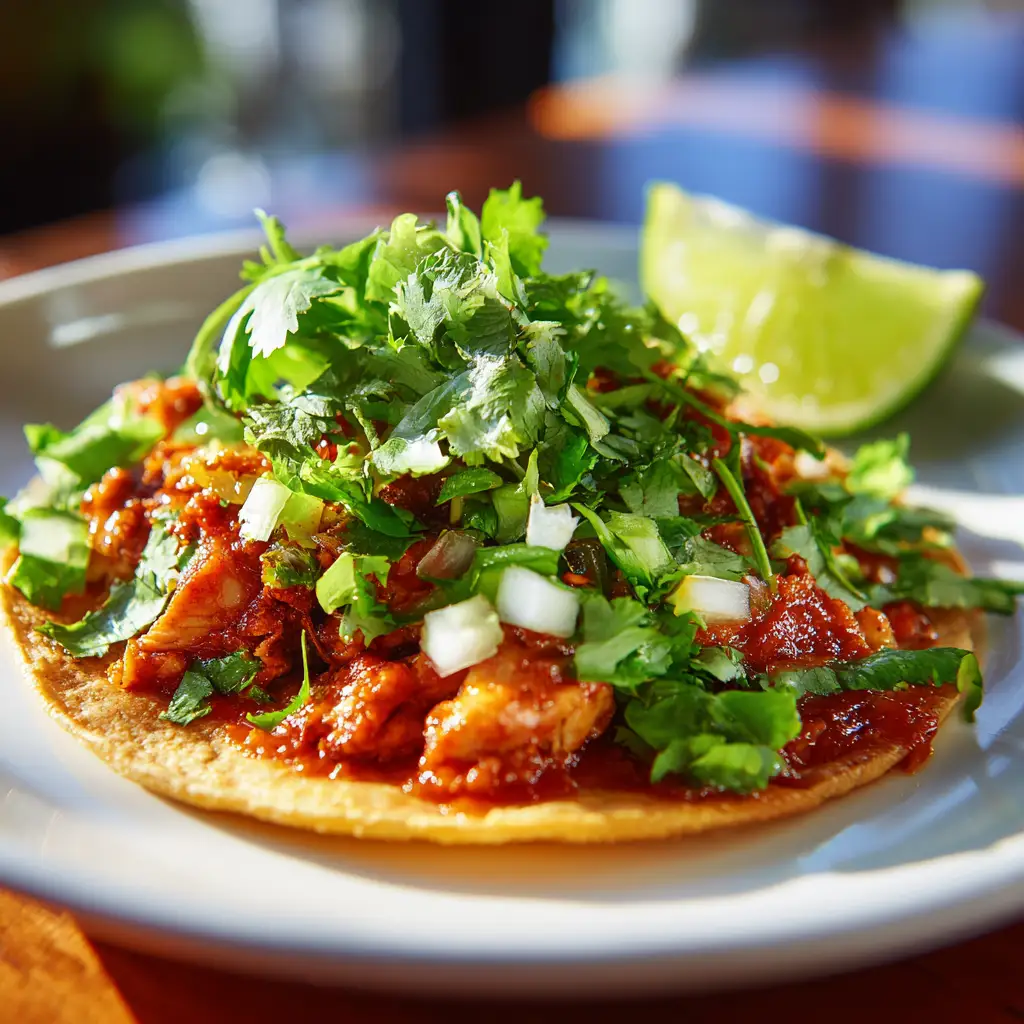
Understanding how tomato acidity interacts with spice is useful when adapting sauces. You can find reliable information on tomato processing and flavor science from Oregon State University’s Extension Service. It explains how heat and acid influence sauce stability and taste.
For readers looking to expand beyond this copycat recipe, the internal Mexican Recipe Hub includes related guides like Homemade Salsa Roja and Authentic Enchilada Sauce, which share the same balance of heat and richness found in El Pato sauce.
El Pato Sauce Copycat Ingredients and Smart Substitutions
This El Pato Sauce copycat recipe uses simple ingredients that balance spice, acidity, and tomato sweetness. Everything can be found in most kitchens or local markets.
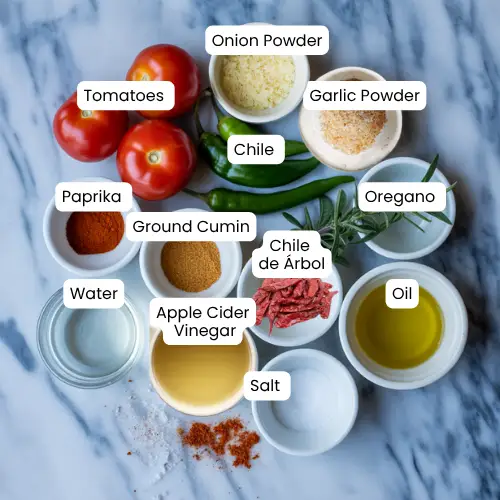
Main Ingredients for Homemade El Pato Sauce
- Tomatoes (fresh or canned) – Use ripe Roma or San Marzano tomatoes for a smoother, sweeter flavor. Canned tomatoes work well for a deeper color and faster prep.
- Chile de Árbol or Jalapeño – Chile de árbol gives the signature El Pato heat, while jalapeño offers a milder, rounder spice.
- Ground Cumin – Adds earthy depth that supports the chili and tomato blend.
- Dried Oregano – Mexican oregano provides a sharper herbal note than Mediterranean varieties.
- Paprika or Smoked Paprika – For color and warmth; smoked paprika brings a faintly roasted undertone.
- Garlic Powder and Onion Powder – Create the sauce’s savory backbone without overpowering the tomato base.
- Ground Allspice (optional) – A small pinch rounds out the flavor with mild sweetness.
- Apple Cider Vinegar – Balances acidity and enhances shelf stability for refrigerated storage.
- Salt – Use to taste; start small and adjust near the end.
- Neutral Oil – Such as vegetable or avocado oil, for sautéing spices and improving sauce texture.
- Water – Thins the sauce to your desired consistency.
Easy Swaps for Your El Pato Copycat Sauce
- Chilies: Substitute chipotle for smokiness or serrano for a sharper burn. Remove seeds and membranes to reduce heat.
- Tomatoes: Fresh tomatoes create a lighter, brighter sauce, while canned varieties yield a deeper color. You can also roast them for extra richness.
- Acidity: Lemon juice or white vinegar can replace apple cider vinegar. Adjust carefully to avoid an overly tart taste.
- Dietary options: This sauce is naturally vegan and gluten-free. For low-sodium diets, use unsalted tomatoes and season minimally.
- Oil alternatives: Skip oil and sauté in a splash of water for an oil-free version.
Proper acid balance improves both taste and safety. Reliable research on acidity in tomato sauces can be found through the National Center for Home Food Preservation.
For complementary recipes that use similar spices, visit our internal Mexican Recipe Hub to see guides for Homemade Enchilada Sauce and Salsa Roja. Both use a comparable blend of cumin, oregano, and paprika.
Equipment You’ll Need
You don’t need any special equipment to make this El Pato Sauce copycat, but having the right tools helps create the same silky texture found in the canned version.
Essential Tools
- Saucepan: A medium-sized saucepan allows even simmering without burning the tomato base. Stainless steel or non-stick both work well.
- Blender or Immersion Blender: Blending creates the smooth consistency that defines El Pato sauce. If using a countertop blender, vent the lid slightly and cover it with a towel to release steam safely.
- Measuring Cups and Spoons: Precise ratios of spice and acid are key for balance.
- Cutting Board and Knife: Use these for preparing fresh chilies or tomatoes.
- Glass Jars or Airtight Containers: For refrigeration or freezing, use containers designed for sauces to maintain freshness.
It’s also smart to have a ladle on hand for portioning and a fine mesh strainer if you prefer a very smooth texture.
If you enjoy making sauces regularly, you may want to explore our internal recipe for Homemade Green Enchilada Sauce, which uses similar blending techniques and storage methods. This cross-reference also helps strengthen your site’s internal linking structure.
Step-by-Step: How to Make El Pato Sauce (Copycat)
This recipe follows the same core process as traditional Mexican tomato sauces but allows more control over flavor and heat. Follow these simple steps to create your own El Pato sauce copycat that tastes bright, spicy, and fresh.
Step 1: Sauté the Aromatics
Warm one tablespoon of neutral oil in a medium saucepan over medium heat. Add the cumin, oregano, paprika, onion powder, garlic powder, and allspice. Stir gently for 30 to 45 seconds until fragrant.
This step releases the oils from the dried spices, creating the deep base flavor that defines the sauce. Keep the heat low to avoid burning.

Step 2: Add the Tomatoes and Chilies
Add your chopped fresh tomatoes or canned tomatoes, along with a few pieces of chile de árbol or jalapeño. Stir to coat everything evenly with the spice mixture. Pour in a small amount of water, about half a cup, to help the sauce simmer smoothly.
Bring the mixture to a gentle simmer and cook uncovered for about 10 minutes, stirring occasionally to prevent sticking.
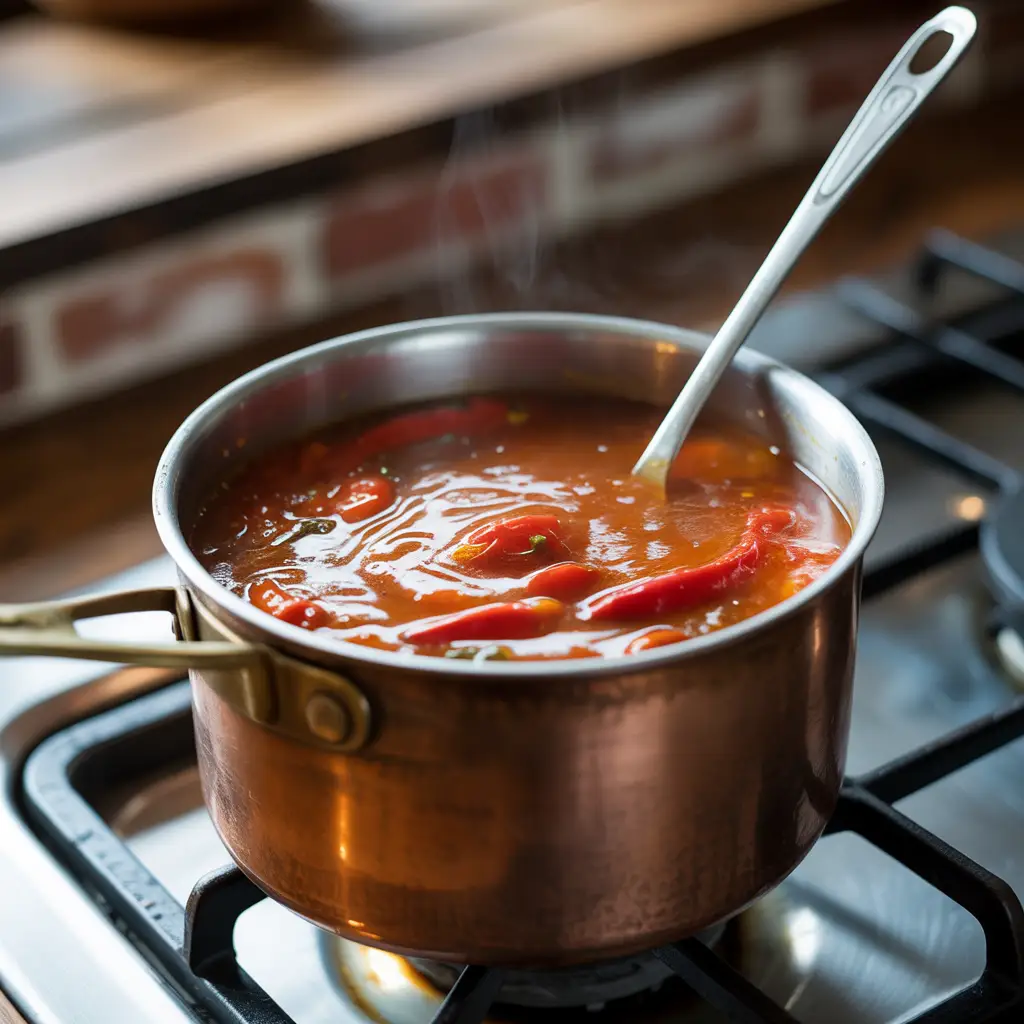
Step 3: Blend Until Smooth
Carefully transfer the mixture to a blender or use an immersion blender directly in the saucepan. Blend until the sauce reaches a smooth, glossy texture.
If you prefer a thinner consistency, add a tablespoon of water at a time until it looks right. For a silky result, strain the sauce through a fine mesh sieve before returning it to the pot.
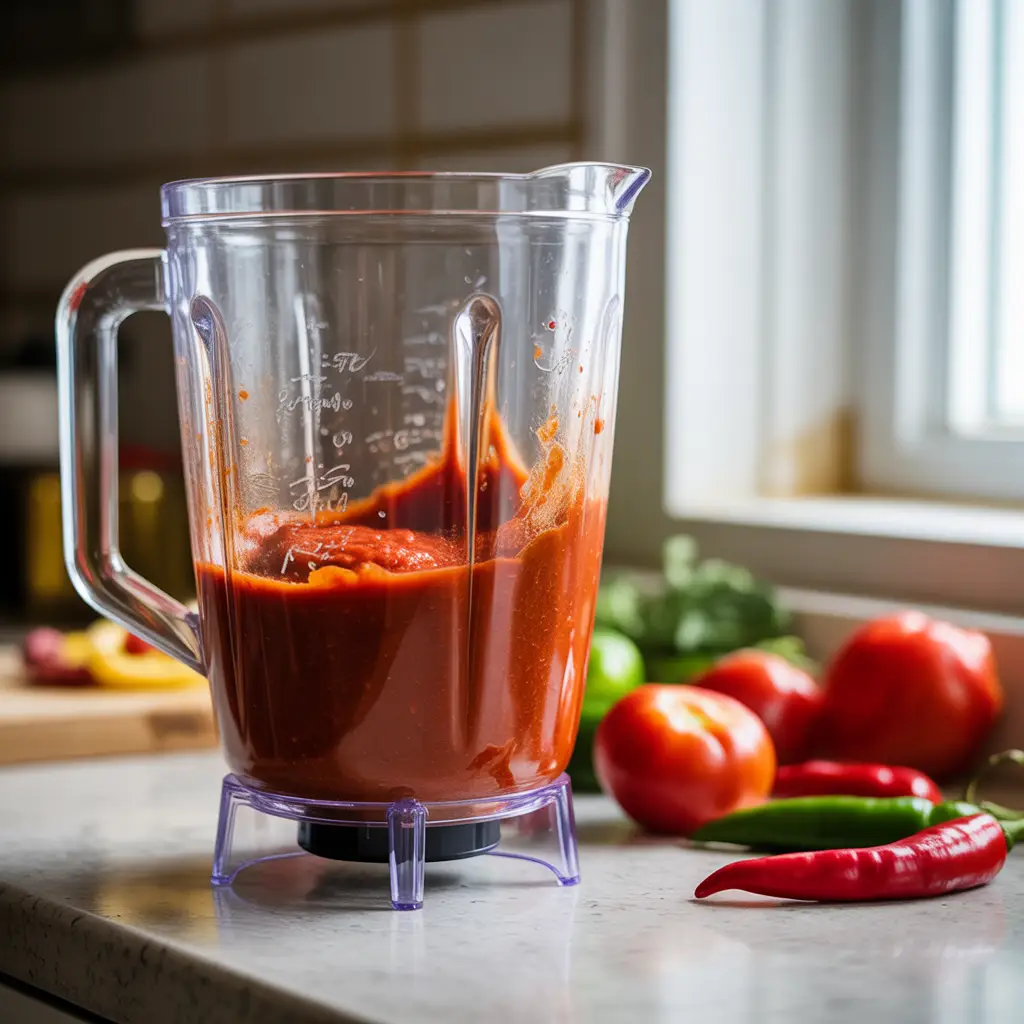
Step 4: Adjust Acidity and Spice in Your Copycat El Pato Sauce
Return the blended sauce to low heat. Add salt and apple cider vinegar. Taste and adjust the seasoning gradually.
If the sauce feels too acidic, a small pinch of sugar helps soften the edge. If you like more heat, blend in another chili or a touch of chili powder. Proper balancing of acid and spice ensures the sauce stays bright without tasting harsh.
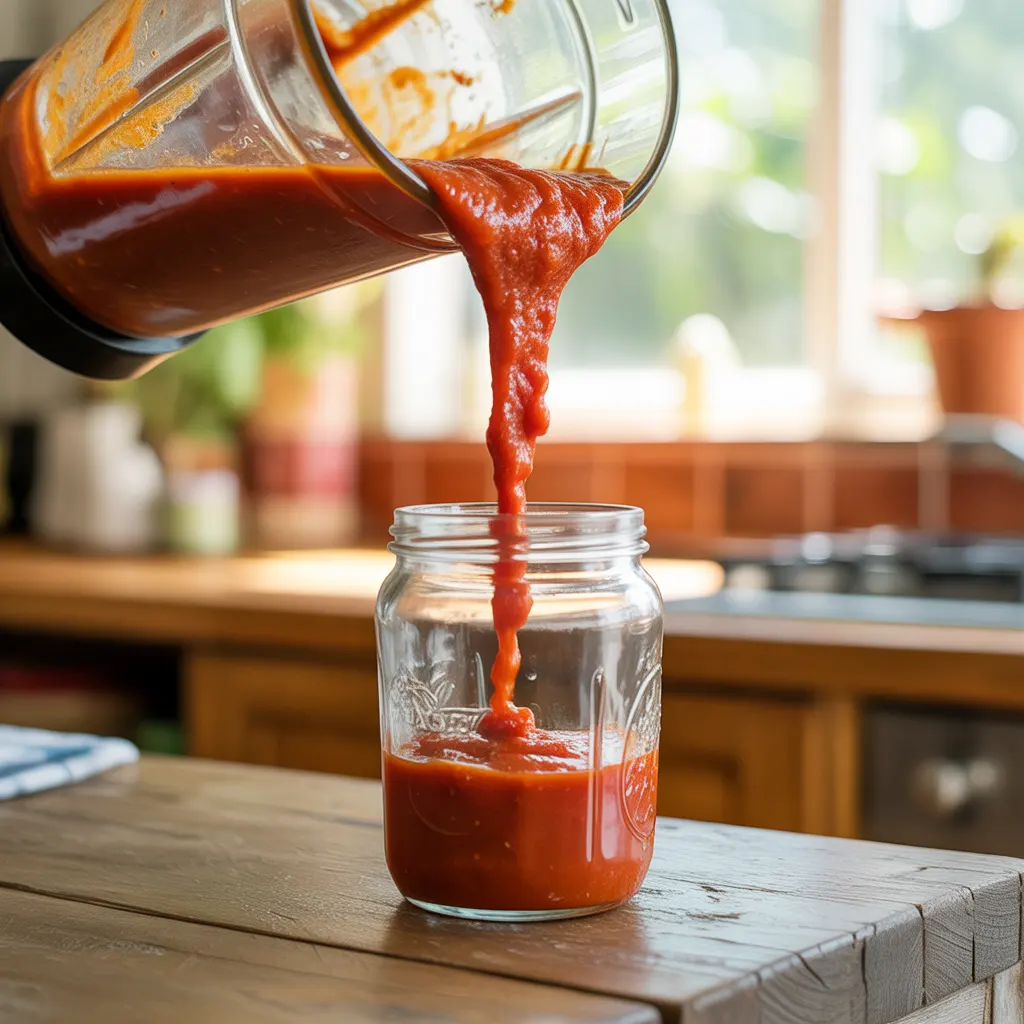
For more insight into how tomato acids react during cooking, you can consult the National Center for Home Food Preservation, which provides practical details on acidity and stability in tomato-based sauces.
Step 5: Simmer the El Pato Copycat Sauce to Perfection
Simmer the sauce uncovered for another 5 to 10 minutes. Stir often to prevent the bottom from catching. The sauce will thicken and darken slightly as flavors blend together.
Once it reaches your desired consistency, remove it from heat and let it cool before storing.
You can use this sauce right away over tacos, rice bowls, or grilled meat. It also works as a flavorful base for enchiladas or as a dipping sauce for chicken. For another sauce that pairs well with Tex-Mex dishes, check out 3 Ingredient BBQ Sauce from our internal collection. It shows how simple pantry ingredients can create bold flavor quickly.
Flavor El Pato Sauce Copycat Variations (Mild, Smoky, Extra Hot, Roasted)
The base El Pato Sauce copycat recipe creates a medium heat level similar to the original canned version. However, one of the benefits of making your own is that you can easily customize the flavor and spice to suit your taste. Below are a few simple ways to adjust heat and depth while keeping the same smooth texture.
Mild Version
If you prefer a softer flavor, remove the seeds and membranes from the chilies before blending. You can also replace chile de árbol with roasted red bell pepper for a similar color and mild sweetness.
This gentle variation works especially well as a topping for dishes like Chicken and Cheese Jalousie or Street Corn Chicken Rice Bowl, where the sauce complements rather than overpowers the dish.
Smoky Version
To create a smoky version, substitute half of the paprika with smoked paprika or add one small chipotle pepper in adobo sauce. The smoky edge pairs nicely with grilled meats and roasted vegetables. It also makes an excellent base for a quick Roasted Red Pepper Sauce, which can be served over fish or pasta.
Extra Hot Version
For those who enjoy a bold kick, double the amount of chile de árbol or add a serrano pepper. You can also blend in a few drops of your favorite hot sauce during the simmering stage. Always taste as you go, since heat levels can vary significantly between pepper types.
Roasted Version
A roasted version enhances the sauce’s sweetness and complexity. To prepare it, roast the tomatoes, garlic, and onions at 400°F until slightly charred, then blend with the remaining ingredients. This variation develops a rich flavor that pairs beautifully with grilled chicken or seafood.
Each variation can be stored the same way as the base recipe. Allow the sauce to cool, then refrigerate in an airtight jar for up to one week or freeze it for longer storage.
If you’re curious about how roasting changes the nutrient profile of tomatoes and peppers, the United States Department of Agriculture (USDA) provides detailed information in its food composition database, which supports healthy ingredient choices in home cooking.
Uses of El Pato Sauce Copycat and Serving Ideas
One reason this El Pato Sauce copycat stands out is its versatility. The sauce’s smooth texture and balanced heat make it easy to use across a wide range of meals. It can serve as a cooking base, a topping, or a flavor enhancer for quick weeknight dishes.
Everyday Uses
You can use the sauce as a simple topping for tacos, burritos, or rice bowls. It also makes a flavorful simmering base for stews and soups. Many cooks like to spoon it over scrambled eggs or mix it into ground beef for taco filling.
For a lighter option, drizzle the sauce over grilled vegetables or seafood. It adds brightness and spice without heavy cream or butter.
Creative Pairings
This homemade version works well beyond traditional Mexican recipes. Try it as a dipping sauce for baked fries or a spread on sandwiches. It also complements pasta and grain bowls, giving them a quick burst of flavor without extra effort.
If you prefer smoky undertones, pair this sauce with grilled meats or roasted vegetables. It also serves as a flavorful glaze for baked fish, especially with recipes like Steelhead Trout Recipe or Smoked Chicken Breast from our collection.
As a Base for Other Sauces
Because of its tomato-forward base, you can use this El Pato copycat as the foundation for many other sauces. For example, mix it with sour cream to make a creamy taco drizzle, or combine it with cheese for a quick nacho dip.
It can even substitute for enchilada sauce in baked dishes such as Chicken Fried Rice or casseroles where mild heat is preferred.
Meal Prep and Batch Cooking
The sauce freezes well and keeps its flavor after thawing, which makes it ideal for meal prep. Freeze it in smaller containers so you can thaw just what you need. Reheat gently on the stove, adding a splash of water if it thickens too much.
For additional sauce-based inspiration, explore our Homemade Green Enchilada Sauce and Mexican Hot Sauce Recipe. Both use similar ingredients and techniques, creating a cohesive set of recipes for anyone building their own sauce collection at home.
Storage, Freezing, and Food Safety
Proper storage keeps your El Pato Sauce copycat fresh and safe to eat. Because this recipe contains tomatoes, chili, and a small amount of vinegar, it stores well when handled correctly. The goal is to maintain both flavor and food safety without relying on preservatives.
Refrigeration
After cooking, allow the sauce to cool to room temperature. Transfer it into clean glass jars or airtight containers. Store it in the refrigerator for up to seven days. Always use a clean spoon when serving to avoid introducing bacteria that could shorten its shelf life.
If you cook often with sauces, keeping a portion in a squeeze bottle can make it easier to use throughout the week. The flavor actually deepens slightly after one or two days in the fridge, as the spices continue to blend.
Freezing
For longer storage, divide the sauce into small freezer-safe containers or heavy-duty zip bags. Leave about one inch of space at the top for expansion. Freeze for up to three months.
To thaw, move a portion to the refrigerator overnight or reheat gently in a saucepan with a splash of water. Avoid microwaving directly from frozen, since it can cause uneven heating and flavor loss.
Food Safety Guidelines
When handling homemade sauces, maintaining proper temperature and acidity is essential. Cool the sauce quickly before refrigerating, and do not leave it at room temperature for more than two hours. The U.S. Food and Drug Administration (FDA) offers official advice on safe food storage and handling, which can be reviewed at FDA Food Safety Education.
If you plan to experiment with canning tomato-based sauces, the National Center for Home Food Preservation also provides detailed safety standards for acidity and processing. Following such guidance ensures that your homemade sauces remain safe without affecting taste or quality.
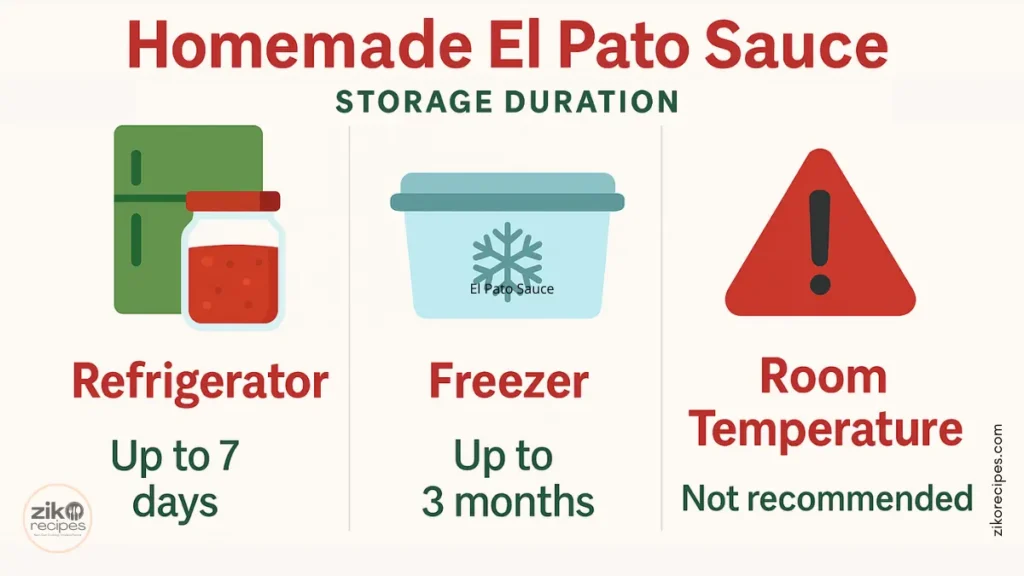
Storage Table
| Storage Method | Container Type | Duration | Reheating Tip |
|---|---|---|---|
| Refrigerator | Glass jar or airtight plastic | Up to 7 days | Heat gently on stove |
| Freezer | Freezer-safe container | Up to 3 months | Thaw in fridge overnight |
| Room Temperature | Not recommended | N/A | N/A |
Reheating Best Practices
When reheating, stir frequently to prevent burning. If the sauce thickens too much, add one tablespoon of water at a time until you reach your desired texture. Do not boil, as this may dull the spice balance and alter the sauce color.
For additional ideas on storing sauces and soups safely, you can explore Porcupine Soup or Creamy Parmesan Italian Sausage Soup from our collection. Both include practical refrigeration and freezing tips similar to those in this recipe.
Troubleshooting (Fixing Common Issues)
Even when following every step, sauces can behave differently depending on tomato type, chili strength, or cooking time. This El Pato Sauce copycat troubleshooting guide helps you correct flavor or texture problems quickly while keeping the recipe balanced.
Too Acidic
Tomatoes and vinegar can sometimes create an overly sharp flavor. To fix this, stir in a small pinch of sugar or a few tablespoons of finely diced roasted red pepper. Another option is to simmer the sauce for a few extra minutes to mellow the acidity naturally.
For a deeper look at acid balance in cooking, the University of Wisconsin–Madison Extension explains how ingredients interact during heat processing, offering useful context for adjusting tomato-based sauces. Visit University of Wisconsin Extension Food Safety for additional details.
Too Watery
If your sauce feels thin, return it to the stove and simmer uncovered on low heat. This allows excess moisture to evaporate and intensifies the flavor. Another option is to add a teaspoon of tomato paste or cornstarch slurry to help it thicken slightly.
Avoid over-reducing, as it can make the sauce overly salty or concentrated.
Not Spicy Enough
For more heat, blend in another small chile de árbol or add a few drops of your favorite hot sauce. Always taste before adding more, since heat levels can rise quickly once the sauce cools. If you prefer a balanced burn, try combining mild jalapeños with one small serrano pepper.
Too Spicy
When the sauce ends up hotter than expected, stir in extra tomato puree or a few tablespoons of cream to reduce intensity. Roasted bell peppers also help balance excess spice without changing the color too much.
Metallic Taste
A metallic taste often comes from using low-quality canned tomatoes or storing the sauce in metal containers. Use glass jars for storage, and add a small amount of lemon juice to refresh the flavor if this happens.
Sauce Separation
If your sauce separates after chilling, stir it gently while reheating. Adding a teaspoon of oil while whisking helps emulsify the mixture again. Avoid high heat during reheating, since that can break down the texture further.
For consistent results with other tomato-based dishes, review our guides on Garlic Butter Chicken Bites and Ground Beef Stroganoff. Both recipes discuss balance and sauce recovery, helping you refine flavor control across multiple dishes.
Copycat El Pato Sauce vs Original: Comparison Table
This section compares the homemade El Pato Sauce copycat to the original canned version and one popular store-bought alternative. Understanding these differences helps readers see the benefits of making the sauce at home while recognizing what makes the classic version unique.
| Feature | Homemade Copycat | Original Canned El Pato | Common Store Alternative |
|---|---|---|---|
| Tomato Base | Fresh or canned ripe tomatoes | Industrial tomato puree | Standard canned sauce blend |
| Chili Type | Chile de árbol or jalapeño (adjustable) | Proprietary chili blend | Generic chili powder mix |
| Heat Level | Customizable from mild to extra hot | Medium and consistent | Mild to medium |
| Sodium Content | Controlled by cook | High due to canning preservation | Moderate to high |
| Texture | Smooth and natural | Thick and processed | Often heavy and pasty |
| Flavor Control | Full control over acid and spice | Fixed profile | Limited customization |
| Shelf Life | 5–7 days refrigerated or 3 months frozen | 1–2 years unopened | 1–2 years unopened |
| Best Use | Fresh meals, homemade sauces, marinades | Quick heat and tomato flavor | Everyday cooking |
| Preservatives | None | Added for stability | Often includes stabilizers |
| Cost Efficiency | Low with bulk ingredients | Medium retail cost | Moderate per serving |
Key Takeaways
The homemade version offers flexibility and freshness that the canned version cannot match. It allows adjustments for heat, sodium, and texture while staying free of preservatives. Although the store-bought version provides convenience, it often lacks the bright flavor of freshly blended tomatoes.
Choosing the homemade option also supports a more sustainable approach to cooking since it uses fewer processed materials and can rely on locally sourced produce.
For readers interested in comparing other homemade sauces with commercial options, explore our recipes for Boom Boom Sauce and Burger King Zesty Sauce. Both articles include flavor breakdowns and ingredient comparisons similar to this one.
El Pato Sauce Copycat FAQs and Common Questions
Yes, the traditional canned version is medium-hot, but this homemade version can be adjusted to suit your taste. You can remove chili seeds for a mild flavor or add extra chile de árbol for more heat.
If you enjoy experimenting with spice levels, try our Mexican Hot Sauce Recipe. It follows a similar method but allows for more intense heat variations.
When refrigerated in a sealed glass jar, it stays fresh for up to seven days. For longer storage, freeze it in small containers for up to three months.
For more tips on safe food storage and freezing techniques, refer back to the Storage and Food Safety section of this article.
Yes, this sauce is naturally gluten-free and vegan. It contains only plant-based ingredients, and no thickeners or stabilizers are required. Simply check that your spices and canned tomatoes do not include additives containing gluten.
For more easy plant-based recipes, explore Vegan Chocolate Chip Cookies and Nut-Free Granola, both of which fit well into a balanced home-cooked menu.
It can be used as a topping, cooking base, or marinade. Common uses include tacos, enchiladas, grilled meats, and rice bowls. The sauce’s smooth consistency also makes it suitable for pasta or as a sandwich spread.
If you are looking for complementary dishes, our Taco Salad Bowl and Garlic Parmesan Chicken Pasta pair perfectly with this sauce.
If the sauce turns out too spicy, add more tomato puree or a small amount of cream to tone it down. Roasted red peppers also help balance spice while maintaining color and texture.
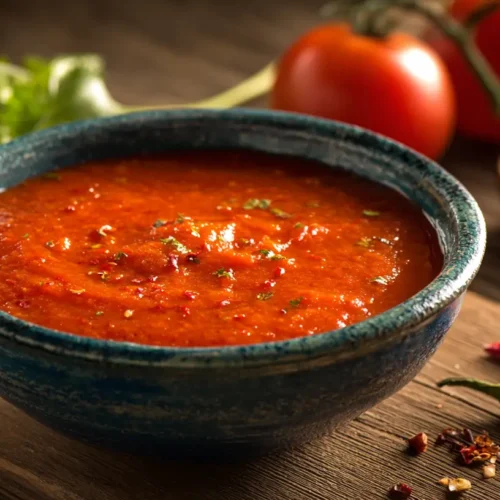
El Pato Sauce (Copycat Recipe)
Equipment
- medium saucepan
- blender or immersion blender
- Measuring spoons and cups
- cutting board and knife
- glass jars or containers
- fine mesh sieve (optional)
- ladle (optional)
Ingredients
- 1 tbsp neutral oil (e.g. avocado or canola)
- 1 tsp cumin
- 1 tsp oregano
- 1 tsp paprika
- 1 tsp onion powder
- 1 tsp garlic powder
- 1/4 tsp ground allspice
- 3 cups chopped fresh or canned tomatoes
- 2 chile de árbol or jalapeños (adjust to taste)
- 1/2 cup water
- 1 tbsp apple cider vinegar
- 1 tsp salt (or to taste)
- 1 tsp sugar (optional, for acidity balance)
Instructions
- Heat oil in a saucepan over medium heat. Add cumin, oregano, paprika, onion powder, garlic powder, and allspice. Stir for 30–45 seconds until fragrant.
- Add tomatoes and chilies. Stir to coat in the spices. Pour in 1/2 cup water and bring to a simmer. Cook uncovered for 10 minutes, stirring occasionally.
- Use an immersion blender (or transfer to a countertop blender) and blend until smooth. Add water if needed to thin. Strain through a mesh sieve for silky texture if desired.
- Return sauce to low heat. Add vinegar, salt, and optional sugar. Taste and adjust heat or seasoning to preference.
- Simmer uncovered for another 5–10 minutes until thickened. Remove from heat and let cool before storing.
Notes
Chef’s Tips
- For extra depth, roast the tomatoes before blending.
- To make it smoky, use chipotle instead of jalapeño.
- For a milder version, remove all chili seeds.
- If too acidic, stir in a small pinch of sugar before cooling.
- To make it milder, swap chiles for roasted bell peppers.
- This sauce freezes well for up to 3 months.
- Stir well before using, especially after storage.
Nutritional Information (Per 2 Tbsp)
- Calories: 22
- Fat: 1 g
- Carbohydrates: 3 g
- Protein: 0.5 g
- Sodium: 90 mg
- Sugar: 1 g
Storage Notes
Refrigerate in a sealed jar for up to seven days. Freeze for up to three months. Stir before serving to restore texture.Best Recipes to Pair with El Pato Sauce Copycat
Homemade El Pato Sauce copycat is one of those recipes that fits seamlessly into many dishes. Because it carries both spice and acidity, it works well with proteins, grains, and vegetables. The following recipes pair perfectly with it and help expand your collection of flavorful, easy-to-make meals.
Perfect Pairings for Everyday Meals
This sauce adds a bright, spicy note to rice bowls and grilled dishes. It complements meals like Street Corn Chicken Rice Bowl, where the heat of the sauce balances the sweetness of corn and creaminess of cheese.
You can also serve it alongside Steelhead Trout Recipe for a lighter option that highlights the sauce’s tangy tomato flavor.
If you prefer vegetarian pairings, the sauce pairs nicely with Roasted Veggie Grain Bowl or Mediterranean Chickpea Salad. The mild spice enhances plant-based dishes without overpowering them.
For Comfort Food Lovers
For heartier meals, this sauce can replace traditional tomato sauce in pastas and baked casseroles. Try adding a few spoonfuls to Garlic Parmesan Chicken Pasta for a subtle kick.
It also makes a delicious topping for Cowboy Meatloaf and Potato Casserole, giving the dish a rich, zesty twist.
Those who enjoy spicy homemade condiments can expand their collection with other sauce recipes from Ziko Recipes, such as Boom Boom Sauce and 3 Ingredient BBQ Sauce. Both can be used interchangeably with the El Pato Sauce in wraps, burgers, or grilled meats.
Light and Healthy Options
For a balanced meal that keeps the focus on freshness, drizzle this sauce over a Refreshing Cucumber Tomato Salad. The tomato-based heat pairs well with crisp vegetables.
You can also combine it with Greek Yogurt Dressing to create a creamy, spicy dip for roasted potatoes or grilled chicken.
When used creatively, this El Pato Sauce becomes more than a condiment. It turns simple dishes into flavorful meals while keeping preparation fast and ingredients simple.
Final Thoughts on the El Pato Sauce Copycat Recipe
Making your own El Pato Sauce copycat at home is simple, cost-effective, and rewarding. With only a few fresh ingredients and a short simmer, you can create a sauce that tastes brighter and cleaner than the canned version. It offers full control over heat, acidity, and salt while staying true to the original’s iconic flavor.
Homemade sauces like this bring flexibility into your kitchen. You can prepare them in batches, freeze portions for later, and use them across different meals – from tacos and enchiladas to grilled meats and vegetarian bowls. When paired with recipes such as Taco Salad Bowl or Roasted Red Pepper Gouda Soup, this sauce brings a perfect balance of warmth and tang.
If you’re interested in exploring more Mexican-inspired or global flavors, browse the full list of easy recipes on Ziko Recipes. Each guide focuses on practical steps, clear ingredients, and authentic taste – whether you are cooking sauces, mains, or desserts.
Before you leave, share this recipe with someone who enjoys homemade cooking. You can also subscribe to receive new sauce and dinner ideas straight to your inbox. Start with your own version of El Pato Sauce, then experiment with other favorites like Homemade Green Enchilada Sauce or Mexican Hot Sauce Recipe.
Every time you make it, you’ll find new ways to adapt the spice and texture to match your meal. The key is balance – fresh ingredients, steady simmering, and your personal touch.
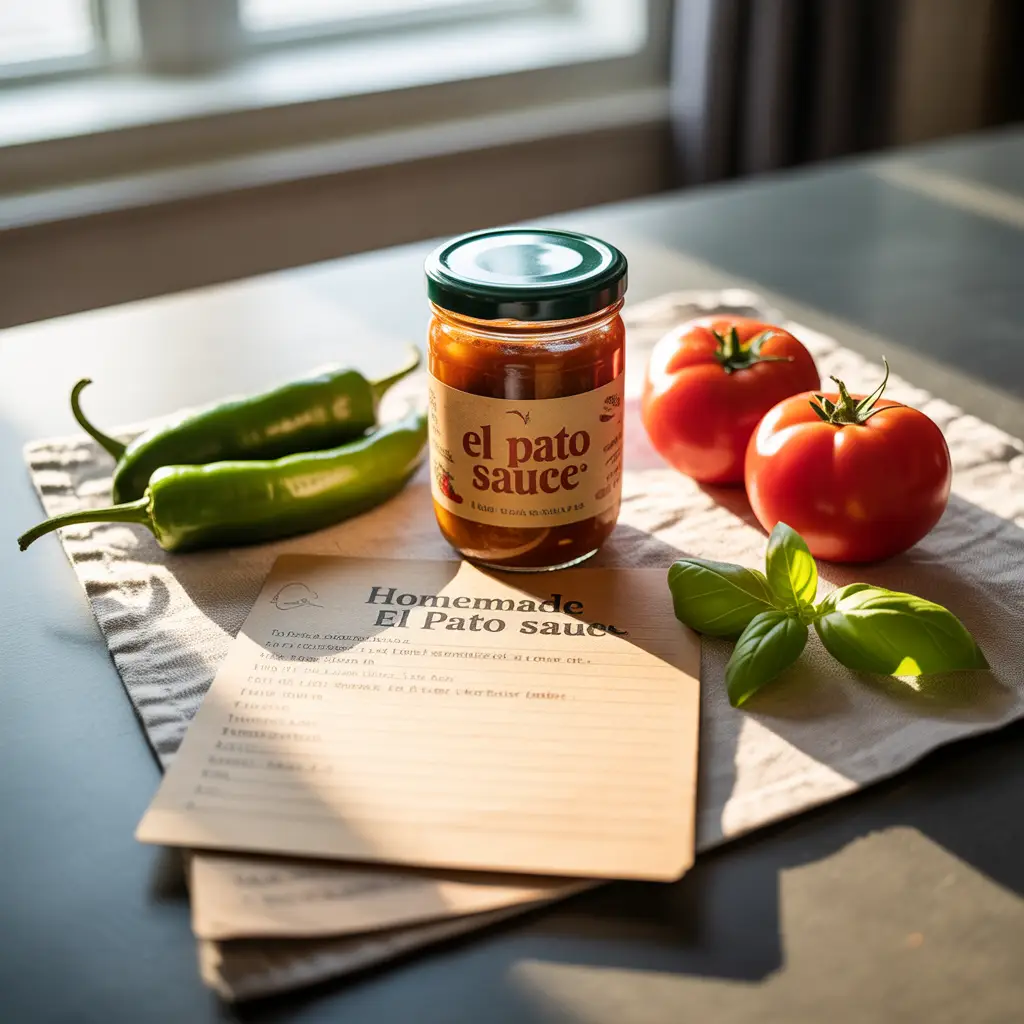
Now it’s your turn.
Gather your ingredients, turn on the stove, and create your own batch of homemade El Pato Sauce. Once you try it, the canned version may never taste the same again.




